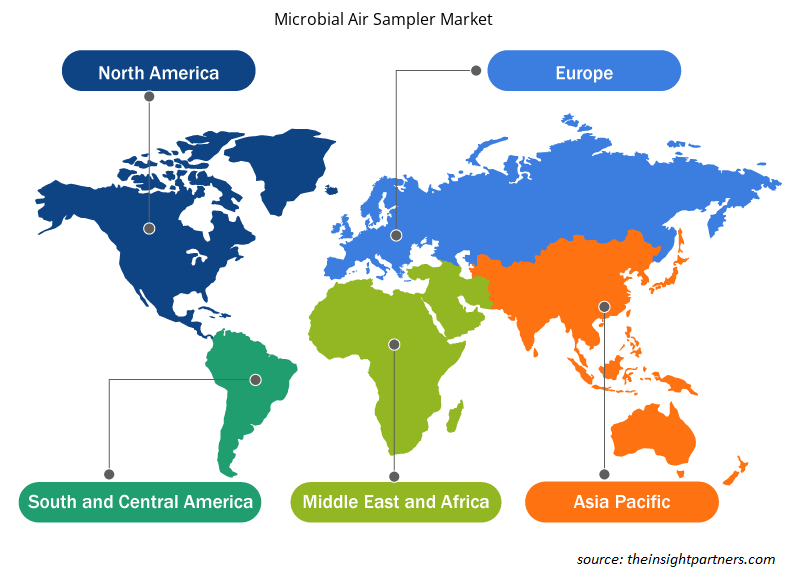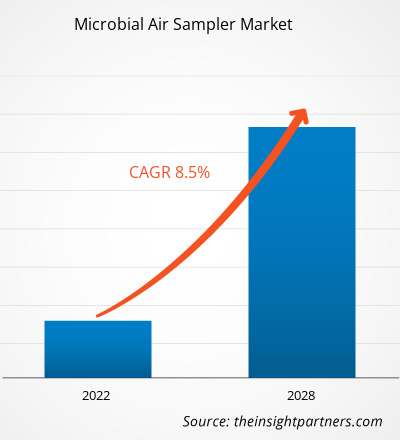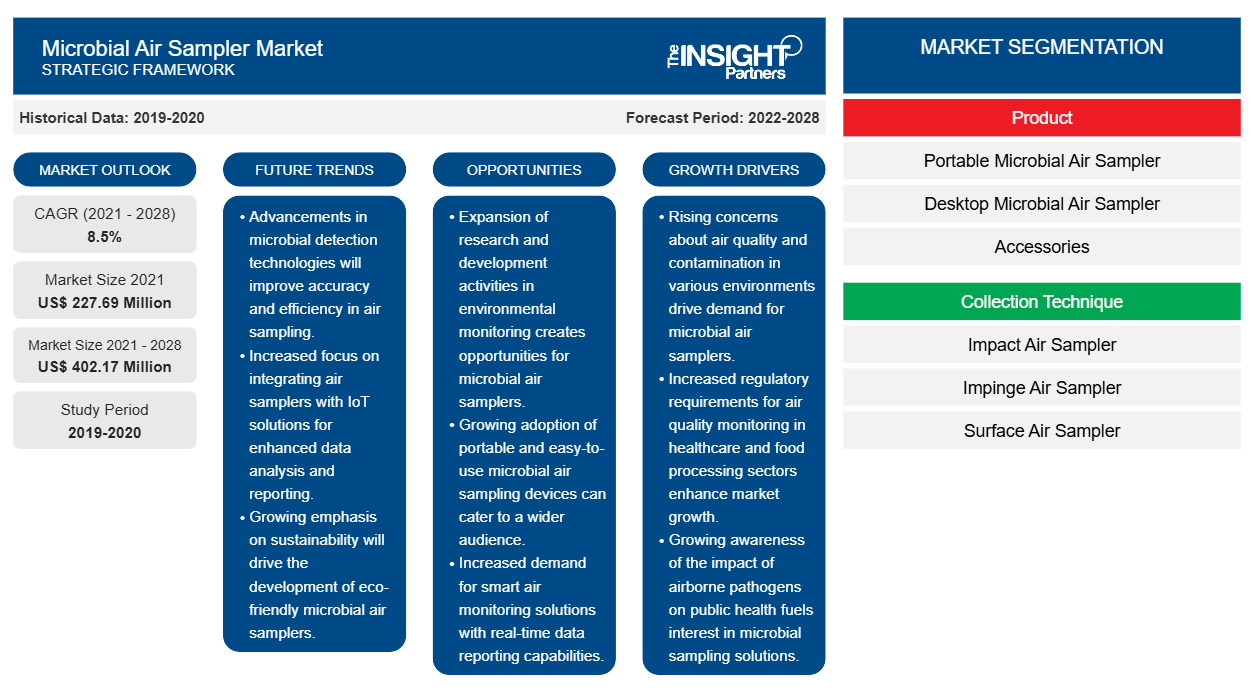Le marché des échantillonneurs d’air microbiens devrait croître de227,69 millions USD en 2021 à 402,17 millions USD en 2028 ; on estime qu'il enregistrera un TCAC de 8,5 % de 2021 à 2028.
Un échantillonneur d'air microbien est un appareil permettant d'examiner les particules microbiologiques dans l'air ou dans un environnement contrôlé. L'échantillonneur d'air microbien fonctionne en forçant l'air dans ou sur un support de collecte pendant une période déterminée. La culture obtenue est ensuite incubée et la présence du microbe dans l'air est évaluée qualitativement et quantitativement. Il peut être utilisé pour l'examen microbiologique de l'air lors des inspections de contamination microbiologique dans les salles blanches et les zones de production sensibles sur le plan hygiénique, ainsi que sur divers équipements utilisés dans l'industrie alimentaire.
La croissance du marché des échantillonneurs d’air microbiens est principalement attribuéeà des facteurs tels que l’utilisation croissante d’échantillonneurs d’air microbiens dans la lutte contre la COVID-19 et l’augmentation des cas de contamination des aliments par des microbes.Cependant, les préoccupations concernant les investissements élevés en capital nécessaires à la création de laboratoires avancés freinent la croissance du marché.
Personnalisez ce rapport en fonction de vos besoins
Vous bénéficierez d'une personnalisation gratuite de n'importe quel rapport, y compris de certaines parties de ce rapport, d'une analyse au niveau des pays, d'un pack de données Excel, ainsi que de superbes offres et réductions pour les start-ups et les universités.
- Obtenez les principales tendances clés du marché de ce rapport.Cet échantillon GRATUIT comprendra une analyse de données, allant des tendances du marché aux estimations et prévisions.
Informations sur le marché
Augmentation des activités industrielles dans les marchés émergents
L'essor de l'industrialisation dans des régions telles que l'Asie-Pacifique, l'Amérique latine et l'Afrique a accru la sensibilisation des populations à la pollution et à la dégradation de l'environnement. Les activités économiques ont le potentiel d'améliorer ou de dégrader la qualité de l'environnement, ce qui peut favoriser ou entraver les opérations économiques. La pollution de l'air ambiant est responsable d'environ 4,2 millions de décès par an dus aux accidents vasculaires cérébraux, aux maladies cardiaques, au cancer du poumon et aux maladies respiratoires aiguës et chroniques. Environ 91 % de la population mondiale vit dans des zones où la qualité de l'air dépasse la limite recommandée par l'Organisation mondiale de la santé (OMS) pour le niveau de polluant. En conséquence, de nombreuses lois de protection de l'environnement ont été promulguées, offrant une opportunité significative pour le marché des échantillonneurs d'air microbiens. Les pays émergents pensent que des lois environnementales strictes auront un impact négatif sur leurs industries « à forte intensité de pollution ». En outre, les réglementations environnementales dans les pays développés sont toujours plus strictes que dans les pays en développement. Au cours des cinq prochaines années, divers changements et de nouvelles normes de sécurité environnementale sont susceptibles d'être mis en œuvre, principalement dans les économies en développement de régions telles que l'Asie-Pacifique en raison de l'augmentation de la pollution et de la contamination de l'environnement. Le développement constant de méthodes de test innovantes pour les échantillons de contaminants tels que les résidus de pesticides, les métaux lourds et les composés organiques devrait contribuer de manière significative à la croissance du marché. En mars 2021, Bertin Technologies a lancé des échantillonneurs d'air Coriolis pour collecter le SARS-CoV-2 responsable de la COVID-19 et évaluer le risque de contamination par aérosol dans les zones critiques. En mai 2021, Aerosol Devices Inc a annoncé la sortie du nouvel échantillonneur BioSpot-GEM conçu spécialement pour les applications sur le terrain, où un échantillonneur de virus simple à utiliser (également pour d'autres particules biologiques) est nécessaire. L'OMS développe une boîte à outils pour des solutions énergétiques propres aux ménages (CHEST) pour surveiller et évaluer les matériaux afin de lutter contre la pollution de l'air domestique.
Informations basées sur les produits
Le marché des échantillonneurs d'air microbiens, par produit, est segmenté en échantillonneurs d'air microbiens portables, échantillonneurs d'air microbiens de bureau et accessoires. Le segment des échantillonneurs d'air microbiens portables détenait la plus grande part du marché en 2021 et devrait enregistrer le TCAC le plus élevé au cours de la période de prévision.
Informations basées sur les techniques de collecte
En termes de technique de collecte, le marché des échantillonneurs d'air microbiens est segmenté en échantillonneurs d'air à impact, échantillonneurs d'air à impact, échantillonneurs d'air de surface, échantillonneurs d'air comprimé, échantillonneurs en temps réel et autres. En 2021, le segment des échantillonneurs d'air à impact devrait détenir la plus grande part du marché et devrait connaître la croissance la plus rapide au cours des prochaines années.
Informations basées sur l'utilisateur final
En fonction de l'utilisateur final, le marché des échantillonneurs d'air microbiens est segmenté en instituts de recherche et universitaires, hôpitaux et cliniques, sociétés pharmaceutiques et biotechnologiques, industries agroalimentaires, soins personnels et autres. Le segment des instituts de recherche et universitaires devrait détenir la plus grande part du marché en 2021 et devrait enregistrer le TCAC le plus élevé au cours de la période de prévision.
Informations basées sur les canaux de distribution
En fonction du canal de distribution, le marché des échantillonneurs d'air microbiens est segmenté en appels d'offres directs, ventes au détail, distributeurs tiers et autres. Le segment des appels d'offres directs devrait détenir la plus grande part du marché en 2021 et devrait enregistrer le TCAC le plus élevé au cours de la période de prévision.
Les lancements et les approbations de produits sont des stratégies couramment adoptées par les entreprises pour étendre leur présence mondiale et leurs portefeuilles de produits. De plus, les acteurs du marché des échantillonneurs d'air microbiens se concentrent sur la stratégie de partenariat pour élargir leur clientèle, ce qui, à son tour, leur permet de maintenir leur nom de marque à l'échelle mondiale.
Aperçu régional du marché des échantillonneurs d'air microbiens
Les tendances régionales et les facteurs influençant le marché des échantillonneurs d’air microbiens tout au long de la période de prévision ont été expliqués en détail par les analystes d’Insight Partners. Cette section traite également des segments et de la géographie du marché des échantillonneurs d’air microbiens en Amérique du Nord, en Europe, en Asie-Pacifique, au Moyen-Orient et en Afrique, ainsi qu’en Amérique du Sud et en Amérique centrale.

- Obtenez les données régionales spécifiques au marché des échantillonneurs d'air microbiens
Portée du rapport sur le marché des échantillonneurs d'air microbiens
| Attribut de rapport | Détails |
|---|---|
| Taille du marché en 2021 | 227,69 millions de dollars américains |
| Taille du marché d'ici 2028 | 402,17 millions de dollars américains |
| Taux de croissance annuel moyen mondial (2021-2028) | 8,5% |
| Données historiques | 2019-2020 |
| Période de prévision | 2022-2028 |
| Segments couverts | Par produit
|
| Régions et pays couverts | Amérique du Nord
|
| Leaders du marché et profils d'entreprises clés |
|
Densité des acteurs du marché des échantillonneurs d'air microbiens : comprendre son impact sur la dynamique commerciale
Le marché des échantillonneurs d'air microbiens connaît une croissance rapide, tirée par la demande croissante des utilisateurs finaux en raison de facteurs tels que l'évolution des préférences des consommateurs, les avancées technologiques et une plus grande sensibilisation aux avantages du produit. À mesure que la demande augmente, les entreprises élargissent leurs offres, innovent pour répondre aux besoins des consommateurs et capitalisent sur les tendances émergentes, ce qui alimente davantage la croissance du marché.
La densité des acteurs du marché fait référence à la répartition des entreprises ou des sociétés opérant sur un marché ou un secteur particulier. Elle indique le nombre de concurrents (acteurs du marché) présents sur un marché donné par rapport à sa taille ou à sa valeur marchande totale.
Les principales entreprises opérant sur le marché des échantillonneurs d'air microbiens sont :
- Appareils aérosols Inc.
- ORUM INTERNATIONAL
- Aquariums Srl,
- Cantium Scientifique Limitée,
- Laboratoires Cherwell,
Avis de non-responsabilité : les sociétés répertoriées ci-dessus ne sont pas classées dans un ordre particulier.

- Obtenez un aperçu des principaux acteurs du marché des échantillonneurs d'air microbiens
Le rapport segmente le marché des échantillonneurs d’air microbiens comme suit :
Marché des échantillonneurs d’air microbiens – Par produit
Marché des échantillonneurs d’air microbiens – Par technique de collecte
- Échantillonneur d'air à impact
- Échantillonneur d'air à impact
- Échantillonneur d'air de surface
- Échantillonneur d'air comprimé
- Échantillonneurs en temps réel
- Autres
Marché des échantillonneurs d’air microbiens – Par utilisateur final
- Instituts de recherche et d'enseignement
- Hôpitaux et cliniques
- Sociétés pharmaceutiques et biotechnologiques
- Alimentation et boissons
- Industries des soins personnels
- Autres
Marché des échantillonneurs d’air microbiens – Par canal de distribution
- Appel d'offres direct
- Ventes au détail
- Distributeur tiers
- Autres
Marché des échantillonneurs d’air microbiens – Par géographie
- Amérique du Nord
- NOUS
- Canada
- Mexique
- Europe
- ROYAUME-UNI
- Allemagne
- France
- Italie
- Espagne
- Reste de l'Europe
- Asie-Pacifique
- Chine
- Japon
- Inde
- Australie
- Corée du Sud
- Reste de l'Asie-Pacifique
- Moyen-Orient et Afrique
- Émirats arabes unis
- Arabie Saoudite
- Afrique du Sud
- Reste du Moyen-Orient et de l'Afrique
- Amérique du Sud et Amérique centrale
- Brésil
- Argentine
- Reste de l'Amérique du Sud et de l'Amérique centrale
Profils d'entreprise
- Appareils aérosols Inc.
- ORUM INTERNATIONAL
- Aquariums Srl,
- Cantium Scientifique Limitée,
- Laboratoires Cherwell,
- Multitech Enviro Analytical LLP,
- Spectrex Corp
- Munro Instruments Limitée
- MERCK KGaA,
- bioMérieux SA
- Analyse historique (2 ans), année de base, prévision (7 ans) avec TCAC
- Analyse PEST et SWOT
- Taille du marché Valeur / Volume - Mondial, Régional, Pays
- Industrie et paysage concurrentiel
- Ensemble de données Excel
Rapports récents
Rapports connexes
Témoignages
Raison d'acheter
- Prise de décision éclairée
- Compréhension de la dynamique du marché
- Analyse concurrentielle
- Connaissances clients
- Prévisions de marché
- Atténuation des risques
- Planification stratégique
- Justification des investissements
- Identification des marchés émergents
- Amélioration des stratégies marketing
- Amélioration de l'efficacité opérationnelle
- Alignement sur les tendances réglementaires























 Obtenez un échantillon gratuit pour - Marché des échantillonneurs d'air microbiens
Obtenez un échantillon gratuit pour - Marché des échantillonneurs d'air microbiens